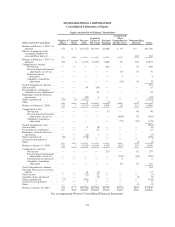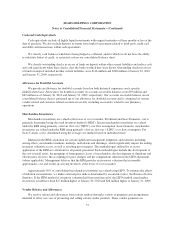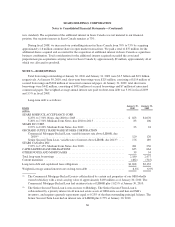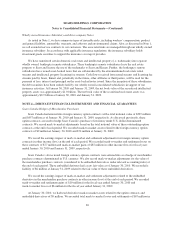Sears 2009 Annual Report Download - page 62
Download and view the complete annual report
Please find page 62 of the 2009 Sears annual report below. You can navigate through the pages in the report by either clicking on the pages listed below, or by using the keyword search tool below to find specific information within the annual report.SEARS HOLDINGS CORPORATION
Notes to Consolidated Financial Statements—(Continued)
Self-insurance Reserves
We are self-insured for certain costs related to workers’ compensation, asbestos and environmental,
automobile, warranty, product and general liability claims. We obtain third-party insurance coverage to limit our
exposure to certain of these self-insured risks. A portion of these self-insured risks is managed through a wholly
owned insurance subsidiary. Our liability reflected on the consolidated balance sheet, classified within other
liabilities (current and long-term), represents an estimate of the ultimate cost of claims incurred as of the balance
sheet date. In estimating this liability, we utilize loss development factors based on Company-specific data to
project the future development of incurred losses. Loss estimates are adjusted based upon actual claims
settlements and reported claims. The liabilities for self-insured risks are discounted to their net present values.
Loss Contingencies
We account for contingent losses in accordance with accounting standards pertaining to loss contingencies.
Under accounting standards, loss contingency provisions are recorded for probable losses at management’s best
estimate of a loss, or when a best estimate cannot be made, a minimum loss contingency amount is recorded.
These estimates are often initially developed substantially earlier than the ultimate loss is known, and the
estimates are refined each accounting period, as additional information is known.
Revenue Recognition
Revenues include sales of merchandise, services and extended service contracts, net commissions earned
from leased departments in retail stores, delivery and handling revenues related to merchandise sold, and fees
earned from co-branded credit card programs. We recognize revenues from retail operations at the later of the
point of sale or the delivery of goods to the customer. Direct to customer revenues are recognized when the
merchandise is delivered to the customer. Revenues from product installation and repair services are recognized
at the time the services are provided. Revenues from the sale of service contracts and the related direct
acquisition costs are deferred and amortized over the lives of the associated contracts, while the associated
service costs are expensed as incurred.
We earn revenues through arrangements with third-party financial institutions that manage and directly
extend credit relative to our co-branded credit card programs. The third-party financial institutions pay us for
generating new accounts and sales activity on co-branded cards, as well as for selling other financial products to
cardholders. We recognize these revenues in the period earned, which is when our related performance
obligations have been met. We sell gift cards to customers at our retail stores and through our direct to customer
operations. The gift cards generally do not have expiration dates. Revenues from gift cards are recognized when
(i) the gift card is redeemed by the customer, or (ii) the likelihood of the gift card being redeemed by the
customer is remote (gift card breakage) and we determine that we do not have a legal obligation to remit the
value of the unredeemed gift cards to the relevant jurisdictions.
Revenues from merchandise sales and services are reported net of estimated returns and allowances and
exclude sales taxes. The reserve for returns and allowances is calculated as a percentage of sales based on
historical return percentages. Estimated returns are recorded as a reduction of sales and cost of sales. We defer
the recognition of layaway sales and profit until the period in which the customer takes possession of the
merchandise.
Cost of Sales, Buying and Occupancy Costs
Cost of sales, buying and occupancy are comprised principally of the costs of merchandise, buying,
warehousing and distribution (including receiving and store delivery costs), retail store occupancy costs, product
62
























